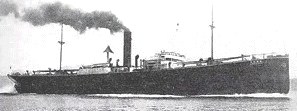RIKUGUN YUSOSEN
 GENOA MARU, prewar)
GENOA MARU, prewar)
IJA Transport GENOA MARU:
Tabular Record of Movement
© 2012-2014 Bob Hackett
11 January 1919:
Nagasaki. Laid down at Mitsubishi’s shipyard as a 6,791-ton freighter for the Nippon Yusen Kaisha (NYK) Line of Tokyo.
5 June 1919:
Launched and named GENOA MARU.
26 June 1919-1941:
Completed and placed in NYK’s Japan ~ North America service.
22 June 1920:
Arrives at Ellis Island, New York from Hong Kong.
11 June 1921:
Arrives at Tacoma, Washington. Berths at St. Paul docks. Loads 1 million feet of lumber including Douglas fir and other timber from St. Paul & Tacoma Lumber Co. and 750,000 feet of timber from the Puget Sound Lumber Co..
12 April 1922:
Arrives at Ellis Island, New York from Yokohama,.
19 September 1923:
Arrives at Ellis Island, New York from Hong Kong,
Keelung, Shanghai and Balboa, Canal Zone.
13 May 1932:
Arrives at Singapore.
13 May 1932:
Departs Singapore for Rangoon, Burma (Yangon, Myanmar) and Calcutta, India.
6 September 1937:
Requisitioned by the Imperial Army (IJA) and converted to a troop transport. Allotted IJA No. 384.
5 January 1940:
Returned to her owners.
21 July 1941:
Re-requisitioned by the IJA.
18 December 1941: Operation "M" (M Sakusen) -The Invasion of the Northern Philippines:
At 1200, GENOA MARU departs Mako, Pescadores for Lingayen Gulf, Philippines in Rear Admiral (later Vice Admiral) Rear Admiral Nishimura Shoji's (39)(former CO of HARUNA) 2nd Lingayen Invasion Unit’s 5th Transport Group (7 ships), with 27 other IJA transports escorted by DesRon 2's light cruiser NAKA, DesDiv 9's ASAGUMO, MINEGUMO, NATSUGUMO, minesweepers W-9, W-10, W-11, W-12, W-17 and W-18 and subchasers CH-4, CH-5, CH-6, CH-10, CH-11, CH-12, CH-16, CH-17 and CH-18.
The Japanese main invasion at Lingayen Gulf consists of three transport echelons. The first is composed of 27 transports from Takao under Rear Admiral Hara Kensaburo, the second of 28 transports under Rear Admiral Nishimura and the third of 21 transports from Keelung under Rear Admiral Hirose Sueto. This force of 76 transports carries the main part of LtGen Homma Masaharu's 80,000-man 14th Army.
24 December 1941:
Lingayen Gulf. Between 0110 and 0430, the Lingayen Invasion Convoy lands troops at Lingayen.
21 January 1942:
GENOA MARU departs Mutsure with transports ATSUTA, BRAZIL, COLUMBIA, DAINICHI, FUSHIMI, HOEISAN, KIZZAN, MAEBASHI, MOTOYAMA, PACIFIC, REIYO SOMEDOMO, SYDNEY, TAKETOYO, TATSUNO, TOFUKU,TOKIWA and TSUYAMA MARUs escorted by CruDiv 9's light cruiser OI and DesDiv 32's ASAGAO, FUYO and KARUKAYA. The transports are carrying the 2nd Infantry Division.
26 January 1942:
Arrives at Mako, Pescadores. Later, the convoy
departs for Camranh Bay to mobilize for the Invasion of Java
18 February 1942: Operation "J" (J Sakusen) -- The Invasion of Java,
Netherlands East Indies:
GENOA MARU is attached to Rear Admiral (later Vice
Admiral) Hiraoki, Kumeichi’s (39) 9th Base Force in Vice Admiral Ozawa
Jisaburo’s Western Java Seizure Force. At 1000, departs Camranh Bay for Merak and Bantam Bay, Java in a convoy also comprised of 55 troop transports.
28 February 1942:
S of Merak, Java. At 2320, GENOA MARU and 29 other transports carrying MajGen Nasu Yumio’s and Colonel Fukushima Kyusaku’s detachments of LtGen Maruyama Masao’s 2nd Infantry Division commence landing their troops.
19 March 1942: "U" transport operation to Burma (U Sakusen):
The First Burma Transport Convoy departs Singapore consisting of 32 ships with main body of the 56th Division: GENOA, AOBASAN, GLASGOW, HAVRE, HARUNA, HIBURI, HOFUKU, HOKUMEI, KAZUURA, KIZAN, KUSUYAMA, KOTOHIRA, MOMOYAMA, MYOKO, NAKO, NAGARA, NAPLES, NICHIRAN, SAKITO, SANKO, SHINAI, SHINANOGAWA, SHINRYU, SHUNSEI, SYDNEY, SUMATRA, TATEISHI, TOKIWA, TSUYAMA and YAE MARUs and two others.
25 March 1942:
The First Burma Transport Convoy arrives at Rangoon, Burma (now Yangon, Myanmar).
19 July 1942:
GENOA MARU departs Takao Formosa for Mako, Pescadores and Yokosuka in convoy No. 236 also consisting of ISUZU, KENZAN and KUNISHIMAMARUs and 16 unidentified merchant ships escorted by auxiliary gunboat (Q-boat) DELHI MARU.
26 July 1942:
Arrives at Yokosuka.
13 January 1943:
GENOA MARU departs Palau a convoy also consisting of SHIRAHA, KENZAN and HOEISAN MARUs escorted by subchaser CH-20 and auxiliary subchasers SHOWA MARU and GANJITSU MARU No. 1.
14 January 1943:
At 1150, auxiliary subchaser GANJITSU MARU No. 1 and cargo ship SHIRAHA MARU are torpedoed and sunk by LtCdr (later Rear Admiral-Ret) Hiram Cassedy's (USNA ’31) USS SEARAVEN (SS-196) at 09-32N, 130-42E. 16 passengers, three gunners and eight crewmen are KIA.
18 January 1943:
Arrives at Manila.
2 June 1943:
At 0800, GENOA MARU departs Saeki for Palau in convoy O-204 for Palau also consisting of KEIZAN, SEIZAN and SHICHISEI MARUs escorted by patrol boat PB-46 and minesweeper W-18.
E 3 June 1943:
W-18 is detached.
11 June 1943:
W of Babelthuap Island, Palau Islands, NW of Palau road entrance. At about 0950, in squall conditions, LtCdr (later Vice Admiral) John A. Tyree’s (USNA ’33) USS FINBACK (SS-230) attacks the convoy. Tyree fires three torpedoes and gets at least one hit forward in GENOA MARU’s No. 1 hold. PB-46 counterattacks unsuccessfully and FINBACK escapes. GENOA MARU continues to flood. At 1730, Abandon Ship is ordered. At 1851, she sinks by the bow at 07-35N, 134-28E. She carried two passengers and 9,300 cartons of foodstuffs, clothes, weapons. One passenger is KIA.
Bob Hackett
Back to
IJA Transports





